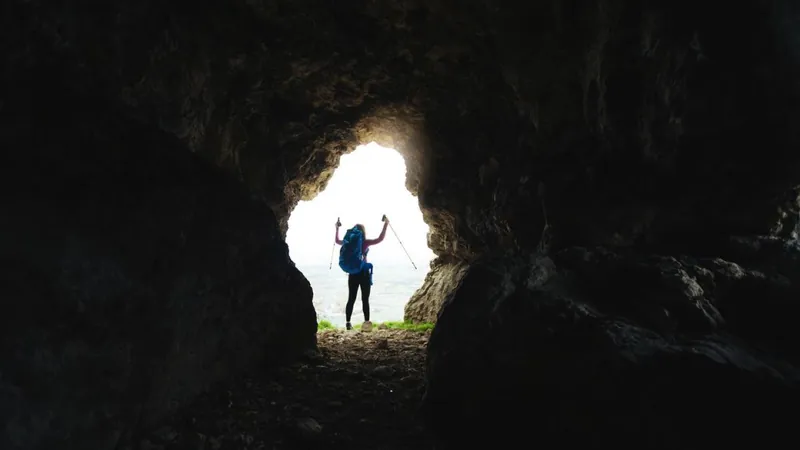
Hiker Unveils 280-Million-Year-Old Fossilized Ecosystem in the Italian Alps: A Journey Back in Time!
2024-11-21
Author: Ying
A Breathtaking Revelation
A breathtaking revelation has emerged in the melting glaciers of the Italian Alps, where a hiker stumbled upon a fossilized world brimming with remnants of ancient life. This incredible discovery, taking place over 5,500 feet above sea level, dates back approximately 280 million years and showcases a thriving Paleozoic-era ecosystem.
Stepping into an Ancient World
Imagine stepping into a world where amphibians roamed, plants flourished, and even raindrops left their mark in the sediment! This ancient ecosystem, meticulously preserved beneath layers of ice and snow for millennia, was unveiled as climate change accelerates the melting of glaciers in the region. The site, located within the picturesque Orobie Valtellinesi Park, has revealed a treasure trove of fossils—including skin prints, plant remnants, seeds, and even the footprints of long-extinct creatures.
Monumental Discovery
The significance of uncovering an entire fossilized ecosystem is monumental. Individual fossils offer insights into our planet's biological history, but an intact ecosystem paints a broader picture of life as it once was. Researchers are astounded by the exceptional preservation of these fossils, allowing them to study details such as the fine imprints of amphibian fingertips and the distinct outlines of ancient reptiles.
Expert Insights
Lorenzo Marchetti, from the Leibniz Institute for Research on Evolution and Biodiversity, emphasized the remarkable quality of preservation at this site. "The extraordinary sedimentary details show us a rich paleo-biodiversity that may even surpass other finds of the same geological age," he stated.
The Discovery Story
The discovery story began last summer when hiker Claudia Steffensen noticed unusual circular designs on the rocks while hiking to escape the heat. Although the day was hot, the unusual rock patterns motivated her to examine further, ultimately leading to the astonishing find that would captivate the scientific community.
A Collaborative Effort
After sharing her initial findings with nature photographer Elio Della Ferrera, the images made their way to the Natural History Museum of Milan. What ensued was a comprehensive research effort, documenting hundreds of fossils still emerging in the high-altitude terrain, which rises nearly to 10,000 feet!
Fossil Footprints
Cristiano Dal Sasso, a paleontologist from the museum, recounted the exciting nature of these fossil footprints, which can provide clues about the size and diversity of the animals that roamed this area long before the age of dinosaurs. "We've identified footprints from at least five distinct animal species, each leaving traces in the soft, water-saturated sands of an ancient environment," he noted.
Preservation Techniques
Researchers believe the layers of clay that formed over the footprints soon after their creation helped preserve these traces, shielding them from erosion while keeping this captivating history intact. Alongside the animal tracks, astonishing plant remains were also discovered, hinting at the vibrant flora that existed in this ancient realm.
An Open-Air Laboratory
Massimo Merati, director of Orobie Valtellinesi Park, described the site as an "open-air laboratory" that is enhancing our understanding of prehistoric life. Modern technology is coming into play as drone and helicopter teams work diligently to map and recover valuable findings from the rugged landscape.
Looking to the Future
As excavations continue, experts anticipate that this fossil deposit will serve as an invaluable research site, not only for scientists but also for students eager to learn more about paleontology and Earth’s history. This remarkable find may very well transform our understanding of the evolutionary past and inspire future generations of researchers.
Stay Tuned for More Discoveries
Curious about what lies beneath your feet? Stay tuned for more incredible discoveries as climate change unveils hidden secrets of our planet's ancient past!



 Brasil (PT)
Brasil (PT)
 Canada (EN)
Canada (EN)
 Chile (ES)
Chile (ES)
 España (ES)
España (ES)
 France (FR)
France (FR)
 Hong Kong (EN)
Hong Kong (EN)
 Italia (IT)
Italia (IT)
 日本 (JA)
日本 (JA)
 Magyarország (HU)
Magyarország (HU)
 Norge (NO)
Norge (NO)
 Polska (PL)
Polska (PL)
 Schweiz (DE)
Schweiz (DE)
 Singapore (EN)
Singapore (EN)
 Sverige (SV)
Sverige (SV)
 Suomi (FI)
Suomi (FI)
 Türkiye (TR)
Türkiye (TR)